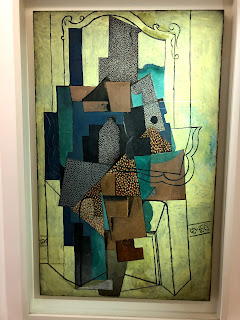Every museum should have bicycle parking facilities--preferably indoors, with a valet.
The Metropolitan Museum in New York offered it briefly, thanks to a collaboration with Transportation Alternatives, when it re-opened after its pandemic-induced closure. I was reminded of that during my latest Paris trip, when I went museum-hopping on the bikes I borrowed and rented.
In nine days, I visited the Rodin, Picasso, Modern Art (twice), Jacquemart-Andre and Orsay Museums. Sidewalk or curbside bike racks stood just outside all of them, secluded from the traffic. Also, there were Velib ports near all of them. So, in Paris it is easier than it is in New York to bike from museum to museum, without having to worry about whether your bike will be where you parked it after spending a couple or a few hours looking at paintings and sculptures. Still, I would love to see indoor facilities--and even more encouragement of, not only cycling in general (which Paris' current mayor seems to be doing plenty of) but of riding to museums and other cultural sites.
 |
| "The Scream" isn't Edvard Munch's only painting. |
I mean, for me, there is nothing like taking in the colors and forms, and the ideas and feelings they convey, after a ride along city streets. The people, buildings and streets I see, almost kaleidoscopically, put me in a mind and mood about how artists see the subjects of their work and transform them into transmissible visions.
Perhaps it has to do with the blood that pumps into my brain as much as the sensory stimuli I experience while riding. That might also be the reason why I can go into "old favorite" museums like the Rodin or New York's Guggenheim, or newer favorites like the Jacquemart-Andre, and feel as if I am, not only re-connecting, but re-discovering.
 |
| Lady Macbeth, by Fussli |
Now, in the Jacquemart- Andre, I sauntered through a special exhibit of Johan Heinrich Fussli, an artist I knew peripherally through his connections with the London literary and theatre worlds of the 18th Century. But its permanent exhibit, like the one in the Rodin, also felt fresh. So did seeing the more as well as the less famous Edvard Munch works in a special exhibit at the Orsay: Even the "Scream" resonated for me, as did the works of Oskar Kokoschka in a Modern Art special exhibit.
 |
| Oskar Kokoschka, self-portrait |
If I were a museum director, I would make bike riding a requirement for entrance. Or, at least, I would offer a discounted admission price. (I can't exclude people who can't ride, after all!) On second thought, if I had my way, all museums would be free. It would be the only policy that would be fair to everybody, wouldn't it?
That I think that way is probably one reason why I never could be a museum director: They have to raise money somehow. But perhaps one will listen to me when I say that cyclists make the best museum visitors. Really, we do.

.jpg)





























